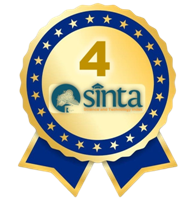A Monitoring System of Water Quality Based on Arduino for Tilapia Pond
Abstract
Full Text:
PDFReferences
M. Yusof Hanan, M. A. Amatul-Samahah, M. Z. Jaapar, N. S. F. Ramli, and S. N. Mohamad, “Moina sp. as Artemia Replacement in The Larval Rearing of River Catfish, Pangasius nasutus (Bleeker, 1863),” J. Appl. Aquac., vol. 36, no. 3, pp. 557–573, 2024, doi: 10.1080/10454438.2023.2290267.
F. N. Afifah and E. Haryatmi, “Design and Control System Monitoring of Water Quality on Tilapia Cultivation Farm based Internet of Things (IoT) with NodeMCU,” InfoTekJar J. Nas. Inform. dan Teknol. Jar., vol. 4, no. 2, pp. 325–329, 2020, [Online]. Available: https://jurnal.uisu.ac.id/index.php/infotekjar/article/view/2398
A. Endut et al., “Real-Time Water Monitoring System for Fish Farmers Using Arduino,” J. Adv. Res. Comput. Appl. J. homepage, vol. 14, no. 1, pp. 10–17, 2019, [Online]. Available: www.akademiabaru.com/arca.html
M. Udin Harun Al Rasyid et al., “Water Quality Monitoring System in Aquaculture Environment Based on Internet of Things,” IET Conf. Proc., vol. 2021, no. 11, pp. 195–200, 2021, doi: 10.1049/icp.2022.0340.
A. A. S. Araneta, “Design of an Arduino-Based Water Quality Monitoring System,” Int. J. Comput. Sci. Mob. Comput., vol. 11, no. 3, pp. 152–165, 2022, doi: 10.47760/ijcsmc.2022.v11i03.017.
Y. P. dan A. S. Willem H. Siegers, “Pengaruh Kualiatas Air terhadap Pertumbuhan Ikan Nila Nirwana ( Oreochromis sp . ) pada Tambak Payau,” vol. 3, no. 11, pp. 95–104, 2019.
A. B. Pulungan, A. M. Putra, H. Hamdani, and H. Hastuti, “Sistem Kendali Kekeruhan dan pH Air Kolam Budidaya Ikan Nila,” Elkha, vol. 12, no. 2, p. 99, 2020, doi: 10.26418/elkha.v12i2.40688.
D. Ndong, Y. Y. Chen, Y. H. Lin, B. Vaseeharan, and J. C. Chen, “The Immune Response of Tilapia Oreochromis mossambicus and Its Susceptibility to Streptococcus iniae Under Stress in Low and High Temperatures,” Fish Shellfish Immunol., vol. 22, no. 6, pp. 686–694, 2007, doi: 10.1016/j.fsi.2006.08.015.
A. F. Bin Omar and M. Z. Bin MatJafri, “Turbidimeter Design and Analysis: A Review on Optical Fiber Sensors for The Measurement of Water Turbidity,” Sensors, vol. 9, no. 10, pp. 8311–8335, 2009, doi: 10.3390/s91008311.
M. U. Ali et al., “Pollution characteristics, mechanism of toxicity and health effects of the ultrafine particles in the indoor environment: Current status and future perspectives,” Crit. Rev. Environ. Sci. Technol., vol. 52, no. 3, pp. 436–473, 2022, doi: 10.1080/10643389.2020.1831359.
Anggara Trisna Nugraha and D. Priyambodo, “Design of Pond Water Turbidity Monitoring System in Arduino-based Catfish Cultivation to Support Sustainable Development Goals 2030 No.9 Industry, Innovation, and Infrastructure,” J. Electron. Electromed. Eng. Med. Informatics, vol. 2, no. 3, pp. 119–124, 2020, doi: 10.35882/jeeemi.v2i3.6.
K. T. Kadhim, A. M. Alsahlany, S. M. Wadi, and H. T. Kadhum, “An Overview of Patient’s Health Status Monitoring System Based on Internet of Things (IoT),” Wirel. Pers. Commun., vol. 114, no. 3, pp. 2235–2262, 2020, doi: 10.1007/s11277-020-07474-0.
J. M. Barcelo-ordinas, M. Doudou, J. Garcia-vidal, and N. Badache, “Self-Calibration Methods for Uncontrolled Environments in Sensor Networks: A Reference Survey,” 2019.
N. H. Wijaya, Z. Oktavihandani, K. Kunal, E. T. Helmy, and P. T. Nguyen, “Tympani Thermometer Design Using Passive Infrared Sensor,” vol. 1, no. 1, pp. 27–30, 2020.
A. Pribadi, N. Irawan, and D. S. Kumar, “MONITORING SYSTEM OF FISH POOL WATER TURBIDITY WITH ESP32 AND BLYNK,” Asia Inf. Syst. J., vol. 2, no. 1, pp. 16–22, 2023.
L. Kirkup, Experimental methods for science and engineering students: an introduction to the analysis and presentation of data. Cambridge University Press, 2019.
J. Gao et al., “Ambient temperature, sunlight duration, and suicide: A systematic review and meta-analysis,” Sci. Total Environ., vol. 646, 2019.
J. Tarigan, A. Bria, A. Bangkit, and S. Umbu, “Rancang Bangun Sistem Pemantauan dan Kontrol Ph Air untuk Budi Daya Ikan Lele ( CLARIAS GARIEPINUS ),” J. Pendidik. Fis., vol. 6, no. 2, pp. 119–129, 2022.
Y. Liu, Y. Chen, and X. Fang, “A Review of Turbidity Detection Based on Computer Vision,” IEEE Access, vol. 6, pp. 60586–60604, 2018, doi: 10.1109/ACCESS.2018.2875071.
DOI: http://dx.doi.org/10.24036/14968171074









